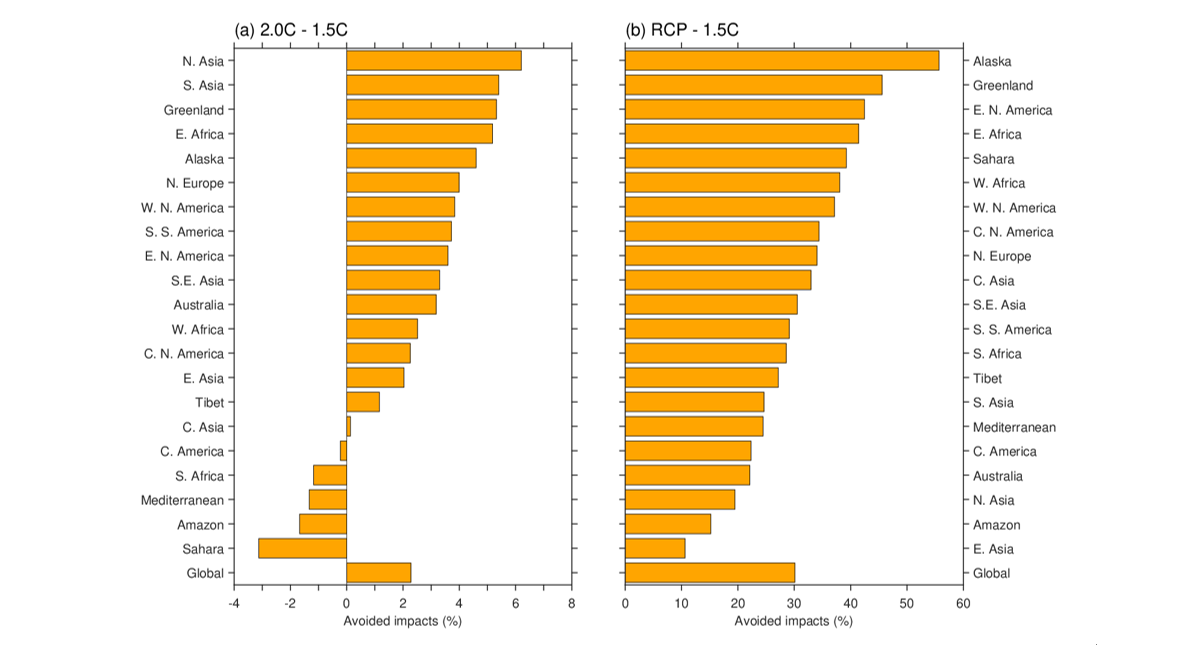联系我们
竺可桢-南森国际研究中心
邮 箱:nzc_iap@mail.iap.ac.cn
邮 编:100029
地 址:北京市朝阳区德胜门外祁家豁子华严里40号 竺南中心

科研进展
Research Progress未来全球增温使人类暴露于极端降水事件中的风险显著增加
Increased population exposure to precipitation extremes under future warmer climates
[2020-07-17]
【中文介绍】
极端降水是全球最为主要的气象灾害之一,每年均造成重大经济损失、生态环境破坏,甚至威胁人们身体健康和生命安全。因此,深入认识未来全球增暖背景下极端降水演变特征及其对社会人口健康风险的影响,对于提高应对未来气候变化的能力具有重要的现实意义。
围绕这一问题,我们基于CESM1模式在1.5℃和2.0℃的平衡态试验以及RCP8.5情景下的多样本试验结果开展系统研究。结果指出,在不同增暖情景下,全球及不同区域极端降水事件均呈现出显著增加的趋势。如果将未来增温控制在2.0 ℃时,相比增温1.5℃,0.5℃的增温将使得全球陆地平均的极端降水日数增加约3.6%,导致社会人口暴露于极端降水事件中的风险增加约2.3%。全球基本呈现出一致的风险增加,尤其在亚洲北部地区,其增加幅度最大。此外,如果对于未来增温不加以控制,其排放遵循RCP8.5情景时,那么未来社会人口暴露于极端降水事件中的风险将急剧增加;相比增温1.5℃时,其暴露风险增加将会超过30%。进一步的研究显示,未来这种风险的增加主要是由于气候变化的贡献,而与未来人口数量的变化关系不大。
【英文介绍】
Precipitation extremes are among the most dangerous climate-related hazards, and these hazards often cause large socioeconomic losses and exert severe human health impacts each year. It is thus crucial to assess future exposure changes to precipitation extremes under different warming scenarios to improve the mitigation of climate change. Here, we project future exposure using a set of Coupled Earth System Model low-warming simulations and RCP8.5 large ensemble simulations. We find that the precipitation extremes are projected to significantly increase over the coming century under different future warming scenarios at both the global and regional levels. Compared to a 1.5 °C warmer climate, the 0.5 °C of additional warming under a 2.0 °C warmer future would increase the number of days of global aggregate precipitation extremes by approximately 3.6% by the end of this century. As a result, the global aggregate exposure is reported to increase by approximately 2.3% if the surface air temperature increases to 2.0 °C rather than 1.5 °C. An increase in exposure is also obvious for most regions across the world, and the largest increase in the future occurs over North Asia in response to the 0.5 °C of additional warming. Furthermore, exposure would increase more rapidly if the temperature increased following the RCP8.5 pathway. The exposure increase varies at the regional level, but in most cases, climate change shows more influential than that of the population; in addition, this influence does not depend on the population outcomes used here.
【关键图表】

【引用格式】
Chen, H. P., J. Q. Sun, H. X. Li, 2020: Increased population exposure to precipitation extremes under future warmer climates. Environmental Research Letter, 15, 034048, https://doi.org/10.1088/1748-9326/ab751f